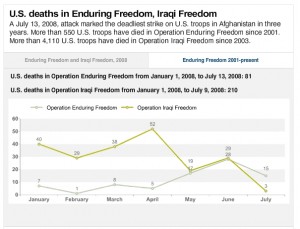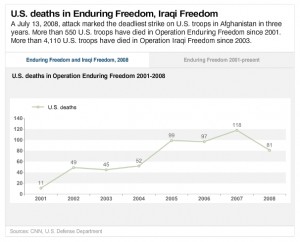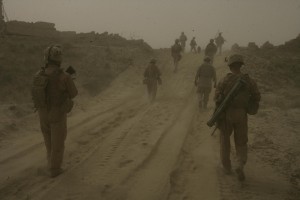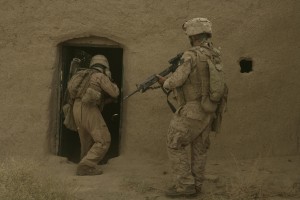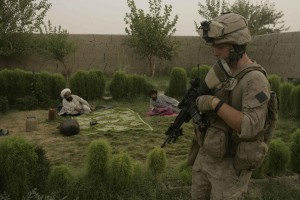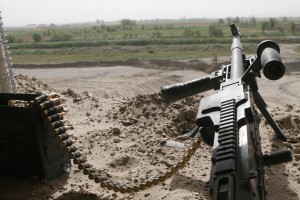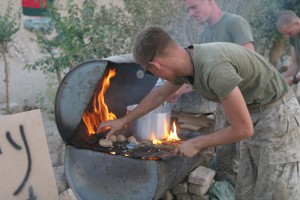In the fall of 2007 British troops in the Garmser area were involved in a firefight in which their rules of engagement placed them in danger, and likely caused the deaths of several troops.
A mission involving British soldiers in Afghanistan in which two men died after coming under heavy enemy fire, had to be stopped for an hour to enable officers to discuss what rules of engagement they were using, an inquest heard today.
The night-time operation near Garmsir on September 8, 2007, described by one soldier as “Operation Certain Death” was led by Major Jamie Nowell.
Giving evidence to the inquest in Trowbridge, Wiltshire today, Nowell said the problems started when he told his air support to open fire on four militants spotted in a trench.
He was then told over the radio that his airborne colleagues were not permitted to engage the enemy.
Nowell explained that his men were under “429 A” rules of engagement, which meant they could engage the identified enemy while the men in the air were on “Card A” which permitted them to fire only in self-defence.
“I could not understand how it happened,” he said.
“Eventually the aircraft was put on 429 A, but it took 60 minutes. The opportunity to engage with the Taliban was lost.”
The incident “dented the confidence of commanders on the ground” he said, but had “no real impact” on the operation as a whole.
A short time later, one of Nowell’s platoons came under heavy fire from the Taliban.
Wiltshire coroner David Masters said it would have “put lives at risk”.
Of course this foolishness put lives at risk, and contrary to Nowell’s confusion, with the preeminence of lawfare over warfare in the battle space today, it isn’t at all difficult to understand how this happened. Since it put lives at risk, and also since the platoon came under fire after the Taliban weren’t engaged, it’s likely that, notwithstanding the assertion that this had no “real impact” on the operations, lives were lost because of this fiasco.
The rules of engagement (outside of a few countries like Poland which allows significant freedom for snipers) look much the same for most Western countries. We have discussed this in More ROE Problems in which we gave the opportunity to study the standing rules of engagement CJCSI 3121.01A, the rules for the use of force CJCSI 3121.02, and the theater-specific rules of engagement for Iraq, and challenged the fact that the ROE and RUF contain no notion of offensive operations. Self defense is the hub upon which all of the rules turn. This also formulated the basis, no doubt, for General Kearney’s misbegotten idea to charge two U.S. snipers with murder because they had targeted a known Taliban who happened not to be holding a weapon at the time.
It is intractable, this refusal to address offensive operations, and it is pathological, this notion that lawfare should hold such an esteemed and prestigious perch in the middle of combat. The Captain’s Journal has worked tirelessly to knock lawfare off of this perch, but lives continue to be sacrificed to this nonsense. Britain apparently suffers from the same stupid ideas of lawyers sitting in sterile offices writing rules for warfare they have never experienced, and to which they will never risk their lives. If it sounds ridiculous for Generals to charge snipers with murder, and pilots to refuse to target the enemy, it’s because it is. Some things are not complicated.
But there is good news, too. While the British experience in Basra was calamitous, and the panicked calls for negotiations with the Taliban by Brown and Miliband were embarrassing, The Captain’s Journal has always claimed that these failures were the fault of high level leadership, not of the rank and file warrior. True enough, there is another side to this engagement after the commanders waxed on about rules written down on paper. It is a story of bravery.
Sergeant Craig Brelsford was taking part in a night-time mission dubbed “Operation Certain Death” behind enemy lines, trying to destroy vantage points near the Taliban stronghold of Garmsir in Helmand Province.
As he and his comrades crept across the landscape of bombed-out buildings and drainage ditches under cover of darkness, the enemy opened fire, immediately felling four of a section of seven soldiers.
The battle that ensued on September 8, 2007 lasted several hours, left two dead and saw three others badly injured.
It became one of the most-documented examples of the bravery of British troops and resulted in clutch of gallantry awards for the regiment, including three MCs, a Conspicuous Gallantry Cross and five Mentions in Dispatches.
One of those killed was Private Johan Botha, 25, from South Africa. According to reports shortly after the incident, Taliban fighters tried to grab his body as a trophy, but the men from A Company the 2nd Battalion, The Mercian Regiment, fought to stop them from as little as 15 yards away.
Sgt Brelsford, 25, from Nottingham, led a team of the men who nicknamed themselves the Spartans back into a stream of bullets and rocket-propelled grenades in a bid to retrieve Pte Botha’s body.
He was killed within minutes, leaving his mother to collect his posthumous MC award for bravery.
Another soldier to receive the MC was Private Luke Cole, 22, who despite suffering serious thigh and stomach injuries, managed to drag himself to a colleague to provide life-saving first aid. He then picked up a rifle to lay down suppressive fire and stop the Taliban taking Pte Botha’s body.
The platoon commander, Captain Simon Cupples, 25, helped to pull two men to safety, including Pte Cole, for which he was later awarded the Conspicuous Gallantry Cross – an honour for bravery second only to the Victoria Cross.
At the inquest into Pte Botha and Sgt Brelsford’s deaths yesterday, he described crawling in the darkness, trying to locate casualties under Taliban fire.
He said he asked Sgt Brelsford, leading another section, to push forward to find Pte Botha while he extracted the other two wounded men.
A few minutes later, he heard a cry of “Man down”.
Capt Cupples said: “All the blokes that night, they all went forward, there was incredible bravery.”
Second Lieutenant Michael Lockett was knocked unconscious during the firefight, but recovered and led another team to extract wounded soldiers, an act for which he too received an MC. “During this incident my life and those of my colleagues were in danger more times than I can remember,” he told the hearing.
As you grab a pint tonight, sit alone for a while and imagine yourself in the middle of this firefight. Say a prayer thanking God for such men, along with similar brave American warriors. Ask for peace for their families, and pray that God continues to grace our lives with warriors of this caliber – in spite of ourselves.
